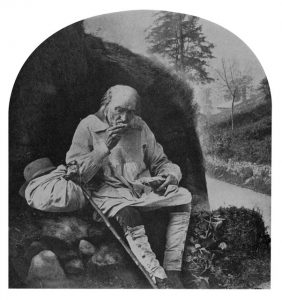I wrote a few months ago about the popularity of smocking in
current women’s fashion. Now I have come
to the conclusion that it is also re-entering male fashion, albeit in a very
small way, at the moment anyway.
This has been helped by ‘cottagecore’, a subcultural online movement, which expresses a yearning for the pastoral, finding solace in nature. An aspirational nostalgia for a simple life, beyond the digital world, it has moved from outsider teen to more mainstream during the Covid-19 Pandemic and lockdown. With anxiety about the future, including the looming global climate crisis, many people sought comfort in the newly renewed natural world, in both urban and rural areas, if only for a couple of months. The animals and birds have taken over the streets was a common news item at the beginning of lockdown. For some, the desire to live from a small piece of land and dressing in a way to express this, is the ultimate goal, even if, in the main, only vicariously lived through online portals.
The styles which have gone with this, for women, have been around for several months, the prairie dress, floral prints, flowing dresses and smocking and shirring. As the Guardian highlighted a couple of weeks ago, cottagecore style for men has begun to go mainstream, celebrities such as Harry Styles and David Beckham, wearing cardigans and flat caps, with online searches for items such as smocks considerably up.
The smock is regarded today much as members of the aesthetic dress movement saw it: associated with rural otherness, hand crafted but practical, hardwearing but decorative – of the country ‘folk’. However, for most of the nineteenth century, it was something else completely, but, in times of anxiety, this version of the smock periodically comes to the fore, adding comfort and representing a nostalgia for a particular manufactured vision of the rural that many yearn for, but which is probably unachievable for most and never really existed anyway.
In some ways, the silver lining of the lockdown was to give us a small slither of an idea of what things might have once been, traffic levels in the UK back to that of the 1950s, few aircraft around, blue skies and birdsong. A brief new reality, where possible, savoured, in brief sorties outside, and now fast disappearing as we return to ‘normal’. The yearning for nature and a simple existence is perhaps amplified, as our anxieties are still un-allayed. Wearing smocks and other cottagecore style clothing, offers a chance to visually express this yearning for change, for purity and a simple life, in a way visible to all, both online and in the street for men and women.
https://www.theguardian.com/commentisfree/2020/apr/15/why-is-cottagecore-booming-because-being-outside-is-now-the-ultimate-taboo
https://www.theguardian.com/fashion/2020/jul/03/david-beckham-leads-the-way-as-men-flock-to-cottagecore-look



